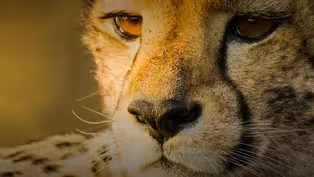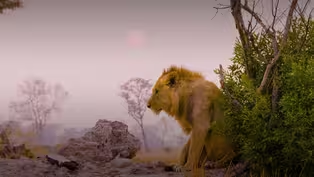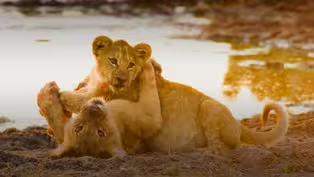
Big Cats Unleashed - Why Are Africa's Big Cats Climbing Trees?
Special | 6m 31sVideo has Closed Captions
In the Okavango Delta, all three of these big cats are taking advantage of an aerial position.
Leopards spend a lot of time up trees, with some of them even hunting from above. What’s less common is seeing lions and cheetahs up in the branches. But in the Okavango Delta, all three of these big cats are taking advantage of an aerial position - and there are various theories as to why they do it.
Problems playing video? | Closed Captioning Feedback
Problems playing video? | Closed Captioning Feedback

Big Cats Unleashed - Why Are Africa's Big Cats Climbing Trees?
Special | 6m 31sVideo has Closed Captions
Leopards spend a lot of time up trees, with some of them even hunting from above. What’s less common is seeing lions and cheetahs up in the branches. But in the Okavango Delta, all three of these big cats are taking advantage of an aerial position - and there are various theories as to why they do it.
Problems playing video? | Closed Captioning Feedback
How to Watch Big Cats 24/7
Big Cats 24/7 is available to stream on pbs.org and the free PBS App, available on iPhone, Apple TV, Android TV, Android smartphones, Amazon Fire TV, Amazon Fire Tablet, Roku, Samsung Smart TV, and Vizio.
Providing Support for PBS.org
Learn Moreabout PBS online sponsorshipMore from This Collection
Big Cats Unleashed is a new exclusive series of short films exploring the Big Cats of Botswana. Featuring unseen moments and shots from Big Cats 24/7, Big Cats Unleashed builds upon the characters we’ve met, taking a deeper look into their lives.
Big Cats Unleashed - Can we save Africa's Big Cats?
Video has Closed Captions
Lions, leopards and cheetahs are threatened across their ranges. But they're thriving in Okavango. (6m 20s)
Big Cats Unleashed - Why These Lions are Outcasts in Their Pride
Video has Closed Captions
Young lions are taking their first steps into becoming adults. (8m 29s)
Big Cats Unleashed - Why Being a (Big Cat) Parent is Not Easy
Video has Closed Captions
Lions, leopards and cheetah are breeding successfully in the Okavango Delta, Botswana, but how? (8m 40s)
Providing Support for PBS.org
Learn Moreabout PBS online sponsorship(light music) (birds chirping) - The first time I saw it, I genuinely thought that my eyes were deceiving me.
It's something that seems to be ingrained within the culture of the pride.
- I've never heard of any other lions in the Okavango Delta who consistently climb trees like our Xudum pride.
- I've got a lioness who is just about to climb a tree.
And this tree is always full of lions.
There's like a queue (laughs) of those who went first, they want to come down, and the one who's right by the sort of exit, she doesn't wanna move off.
He's standing there like, "Come on, darling.
We gotta get down."
(lions growling) (birds chirping) (lion roars) (sirens wailing) - [Narrator] It's not uncommon for your neighborhood cats to climb trees.
Big shout out to all the firefighters out there.
But lions bounding up the branches, that's actually kind of weird.
And there are theories about why this population started doing it.
- It definitely seems to be a seasonal thing.
When I first arrived here, didn't see any lions in trees, and now it is a daily occurrence.
I think it's a lot warmer, there's a lot more biting insects around.
- I mean, we can see the heat waves coming off the ground all the time, so just getting that extra height might allow them to get some of that really nice breeze that's moving through.
(flies buzzing) - The lioness on the ground has a lot of flies surrounding her.
And, yes, the one up the tree has the better idea.
She doesn't have any flies.
So climbing up a tree does help.
(light music continues) - [Narrator] And flies might not be the only thing these ladies are trying to avoid.
(cub purring) - From the very young age, those little cubs start learning how to climb trees, I think trying to chase their mom for some milk.
This tree meant to be for the grown-ups.
Cubs can be really, really annoying.
(laughs) - [Gregory] Those mums have worked it out.
You get into a tree that's just a little bit too tall for the cubs, and it's like a payback.
(cub whimpers) - [Narrator] Whatever the reason behind their tree-climbing capabilities, there's still some aspects of being a lion that just aren't cut out for a life in the branches.
(bird chirping) - They're bulky and big.
A female lion will get up to 130 kilograms, 150 at the max.
And a male lion may be even pushing 200 to 250 kilograms.
And if you fall from a height at that weight, there's a good chance you're gonna hurt yourself.
- Watching this lioness go up the tree is so funny because she has got such a straight line between her shoulders and her back.
There's absolutely no give there whatsoever.
And that's so different to the curved backs of leopards, like Xudum.
When Xudum climbs a tree, her shoulder blades are so flexible and they move with her, whereas this lioness just looks so awkward, and she looks like she's got a plank of wood on her back.
(light music continues) - [Narrator] Lions might not exactly be built for it, but their ability to climb trees presents a novel problem for the area's leopards.
(light tense music) - One particular incident was one of the lionesses managed to climb into a tree with a big male leopard and steal a warthog kill from him.
I mean, it was unbelievable.
They got both into the same tree and she tried to chase him up into the tree, and then he was like, (growling) and she was like, (growling) (lion and leopard growling) and it was just massive drama in this tree.
It was an exceptional thing that I've only seen a handful of times.
- [Narrator] When they're not losing their lunch to tree-climbing lions, a tree-top vantage point can provide leopards with a number of benefits.
(light music) - It gives them safety and security from other big predators.
They're able to safely secure food, safely stash their cubs.
It also gives them an amazing vantage point to scan their area, and they'll often spend a lot of time going up and down and up and down just to kind of get a better view of what's going on in their terrain.
- When you watch them, they're almost thinking about things very intently, planning how they're gonna approach prey, and they're very mindful hunters.
- [Narrator] Some leopards use certain trees for a spectacular hunting behavior.
- The sausage tree has a flower with very sweet nectar, while from the jackalberry, there's a yellow fruit.
Our leopard Xudum knows that the prey will come in to eat these.
- The more time you spend with them, the better you understand when they're going to do specific things.
Their tails twitch, their feet kind of lock into place, and within two seconds, there's leopards flying out of the tree.
- Jumping from full trees onto prey is incredibly risky.
There's a lot at stake.
An injured leopard is almost as good as a dead leopard, because unlike lions, they have no backup.
There's no one else to look after them.
- [Narrator] Leopards aren't the only solitary big cats in the Okavango, but cheetah don't generally share their tree-climbing prowess.
- The reason why they don't typically climb trees is because their claws and feet are not really designed for that.
They don't have retractable claws.
So their claws are blunted by running, and that obviously doesn't help when you're trying to find your way up into a tree.
If they need to go through a short part of the trunk, they'll run up and use their momentum to kind of get onto a fork.
And then from there, they can kind of look around.
- Cheetah, which we've now discovered is a male, just climbed a tree very, very quickly and is using the tree as a lookout point.
He's just scoping out the area to see if there's any prey about.
- [Narrator] Whether it's for safety, to hunt, or just for a bit of peace and quiet, the area's big cat species all spend at least some of their time in the branches.
(light music continues) But there's still one age old question left unanswered.
- Do cats always land on their feet?
I can say I've seen our cats falling out of trees, and I've never seen them not land on their feet.
(light music concludes) (insects trilling)

- Science and Nature

Explore scientific discoveries on television's most acclaimed science documentary series.

- Science and Nature

Capturing the splendor of the natural world, from the African plains to the Antarctic ice.












Support for PBS provided by:


